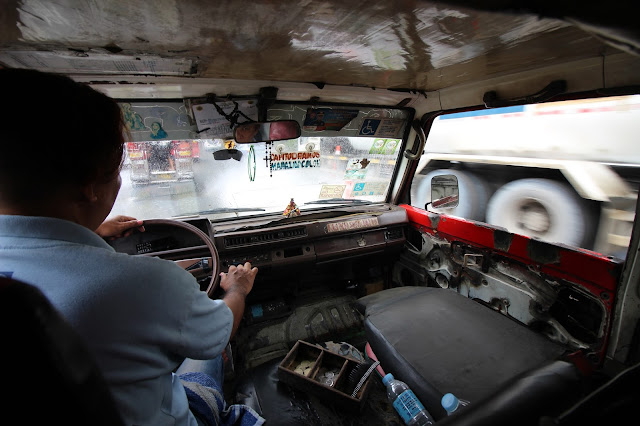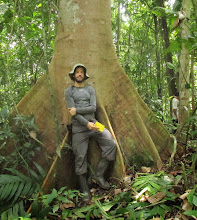Okay, time to explain the name behind this blog. I'm a forest guy. I research forests and I love to photograph big trees. The bigger, older and the more gnarly, the better! However, most splendid forest scenes cannot be captured adequately within a regular camera lens frame so on this trip I’ve packed a Canon 10-18mm lens to capture what I am after. On previous trips I’ve brought a 17mm, once hauling it and a full-size tripod by bicycle 11,000 km to Panama on a big tree mission, but that is whole other story.
In the beginning of this trip, I scantily saw any impressive forest. The Philippines as I found out is seriously deforested with only 3% of the country’s primary forests remaining. Its an ideal place to see scraggly degraded forest, but not so much big trees. I was quite disappointed. The big tree lover I am, I resorted to praying for big trees.
The Philippines is a strongly catholic nation so to fit in I went to a place to pray. I went to see the incredible old cathedrals located in most main towns. And holy moly... my prayers were answered!
The Philippines is a strongly catholic nation so to fit in I went to a place to pray. I went to see the incredible old cathedrals located in most main towns. And holy moly... my prayers were answered!
By these grand cathedrals, I found giant old large trees planted out front. In the village of Ronda, a small coastal community just a short excursion from the paradise snorkelling destination of Moalboal (fyi, which we loved) we found the biggest tree yet. It’s big gnarled trunk was somehow reminiscent of an elephant. I actually spotted it from far away from our speeding bus, and then we returned with a rented scooter the next day for a closer look. The giant was an estimated 2 m in diameter trunk and about 26m tall with an impressively wide umbrella crown. The locals mingling under its shade told me it was an acacia. (I couldn’t tell you otherwise; my tree knowledge is terrible so far on this trip). Whatever it was, it was by far the largest tree I saw in the Philippines.
Side note, Moalboal was probably our favourite destination in the Philippines. The beach-access snorkelling brought us head to head with major schools of sardines as well as leatherback sea turtles and sea snakes. Nearby, Kawasan Falls and other hidden little beaches were fantastic treasures to discover too.
 |
| Moalboal, the Philippines. |
 |
| Flora cooling off in Kawasan Falls, near Moalboal, the Philippines |
 |
| Ubay, the Philippines |
Meanwhile, this stunning old-cathedral in Lomboc, Bohol Island, was damaged by an earthquake in 2013. At the rate that the surrounding tropical vegetation is encroaching, it could become an old-growth forest itself within a century...
 |
| Okay, the most interesting shot from Lomboc cathedral happens to be this one... |
In many regions around the world, you will find large trees located near churches. For example, some of the oldest trees in the world are outside churches in the UK, such as the >3,000 year old Fortingall Yew. The tree with the largest trunk diameter on earth towers, stupendously, over a small church in Oaxaca, Mexico. The giant tree called ‘El Tule,’ which by the time I visited it had already witnessed the rise and fall of major ancient civilizations in the region makes El Nino look small. When I was cycling through Mexico on another trip a local informed me of an ancient tamarindo tree with a heavy brass bell hanging from an old crooked branch to mark it as a place of worship. The local villagers there told me that it was planted 500 years ago; it would then have begun to grow around when Europeans arrived to North America.
 |
| Ancient tamarindo tree in Jalisco, Mexico. Can you spot the huge bell hanging from its branch!? |
Through my travels and research I've gained some ideas to explain the role of large trees in people's culture and spiritual beliefs. For starters, some species have a more important role than others. To some indigenous people, particular tree species have particular traditional uses, which results in the tree becoming greatly important to their culture. For example, the First Nations of western north america carved totem poles and great canoes from the wide trunks of western red-cedar. They used cedar bark for basketry and cedar foliage for spiritual cleansing. Their cultural appreciation has built over millenia of use into it becoming woven deeply into their way of life.
 |
| Ancient redcedar tree along the Oregon Coast. Photo from Instagram @vanbigtrees |
Other times, the tree goes well beyond uses. To the Mayans, the kapok (Ceiba pentandra) tree bears enormous spiritual significance because the Mayans history and ontology places the tree at a central point in their understanding of the origins of life and belief in the afterlife. Cultural connections to large and old trees is often expressed through local laws against harming the trees and strong repercussions against violators.
 |
| Not a particularly nice looking Kapok, but one the locals seemed to regard highly in Belize. Photo from bike touring Central America |
When traveling you will often find large and old trees embedded in the spiritual and physical landscape of local peoples. You'll find both trees planted at community meeting and worship sites, and cultural sites that have sprung up beside the ancient trees. Regardless, of which came first, these trees are often used for community gatherings under their beautiful shade. Enduring social relations form under the trees and carry forward in some way over generations. As in many of my other big tree experiences, I was happy to exchange smiles and enthusiasm with curious locals who always seem happy to see a westerner find simple joy in their beloved old tree.

















